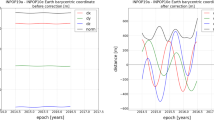Abstract
Near-Earth Asteroids (NEAs) are Solar system special class objects attracting the attention of astronomical community especially during several of the last decades. To some extent the NEAs have an advantage over the minor planets of the main belt: due to close and regular approaches to the Earth the radar observations of NEAs can be obtained for the greater number of objects than for those of the main belt of the minor planets. In this paper the use of all available radar observations together with optical ones resulting in the combined data analysis solution is discussed for different problems such as the asteroid orbits and catalog orientation parameters determination. In particular the problem of the motion of the dynamical equinox in the Hipparcos reference system is considered. About 13000 radar and optical observations of 24 NEAs and main belt minor planets have been used to obtain the precise asteroid orbits, FK5 catalogue orientation parameters and the motion of the dynamical equinox from 1750 till 2000 in the Hipparcos system.
Similar content being viewed by others
References
Batrakov, Yu. V. and Chernetenko, Yu. A.: 1997, ‘On determination of the zero-points of FK5 using observations of minor planets in Nikolaev’, in: J. Vondrak, and N. Capitane, (eds), Journess 97. Systemes de Reference Spatio-Temporels, Prague, 22-24 September, 23.
Blackwell, R. L.: 1977, ‘Equinox-position and motion during 250 years’, Month. Not. Roy. Astron. Soc, 180(2), 65.
Branham, R. L. and Sanguin, J. G: 1994, ‘The FK5 equinox and Equator’, in: Lopez Garcia A. et al., (eds), Proceedings of Third International Workshop on Positional Astronomy and Celestial mechanics, Valencia, Spain, 429–435.
Duma, D. P. and Kozel, O. V.: 1998, ‘If nonprecessional equinox motion is real?’, J Kinemat Phys Celest Bodies. Kiev, (in Russian).
Fricke, W.: 1985, ‘Fundamental catalogues, past, present, future’, Celest.Mech & Dyn Astr., 36, 207.
Jordi, C. and Rossello, G.: 1987, ‘Corrections to the FK5 reference frame’, Mon. Not. R. Astr. Soc., 225, 723.
Kolesnik, Yu. B.: 1995, ‘Analysis of modern observations of the Sun and inner planets’, Astron. Astrophys. 294, 874.
Krasinsky, G. A. and Vasiliev, M. V.: 1996, ‘ERA: Knowledge base for ephemeris and dynamical astronomy’, in: I. M. Wytrzyszczak,J. H. Lieske, and R. A. Feldman. (eds), Proceedings of IAU Colloquium 165, Poznan, Poland , July 1-5, 239–244.
Mignard, F. and Froeschle, M.: 1997, ‘Comparison of the FK5 frame to Hipparcos’, in: 'Hipparcos-Venice 97', Venice, Italy, May 13-16 ESA SP-402, 57.
Poppe, P. C. R. et al.: 1998, ‘Analysis of solar astrolabe measurements during 20 years’, AJ 116(5), 2574–2582.
Shuygina, N. V. and Yagudina, E. I.: 1995, The FK5 equinox and equator from combined radar and optical data of near-Earth asteroids. in: Ferraz-Mello S. et al., (eds) Proceedings of the 172nd Symposium of the IAU, Paris, France, July, 3-8, 469–474.
Stand ish, E. M. Jr.: 1990, The Observational Basis for JPL's DE200, Planatary and Lunar Ephemerides of the Astronomical Almanac. Astron. Astroph. 233, 252–271.
Vityazev, V. V. and Yagudina, E. I.: 1997, ‘The motion of dynamical equinox: present day status and proposal for the post-Hipparcos era’, in: J. Vondrak and N. Capitane, (eds), Proceedings of Journees 1997 Prague, 153–156.
Yagudina, E. I.: 1996, ‘The FK5 zero point corrections by radar and optical data of near-Earth asteroids’, in Lopez Garcia A. et al. (eds), Proceedings of Fourth International Positional Astronomy and Celestial Mechanics, Penyscola, October 7-11, 59–64.
Yao, Z. G. and Smith, C.: 1993, Equator and equinox solutions from meridian circle observations of the Sun, Mercury and Venus at the Cape of Good Hope and the U.S. Naval Observatory from 1907 to 1971, in: I. I. Muller and B. Kolaczek (eds), Development in Astrometry and Their Impact on Astrophysics and Geodynamics, Kluwer Academic Publishers, 403.
Yeomans, D. K. et al.: 1991, ‘Asteroid and comet orbits using radar data’, Astron.J, 103 (10), 303–317.
Rights and permissions
About this article
Cite this article
Yagudina, E.I. The use of radar observations of Near-Earth Asteroids in the determination of the dynamical equinox. Celestial Mechanics and Dynamical Astronomy 80, 195–203 (2001). https://doi.org/10.1023/A:1012214007630
Issue Date:
DOI: https://doi.org/10.1023/A:1012214007630



